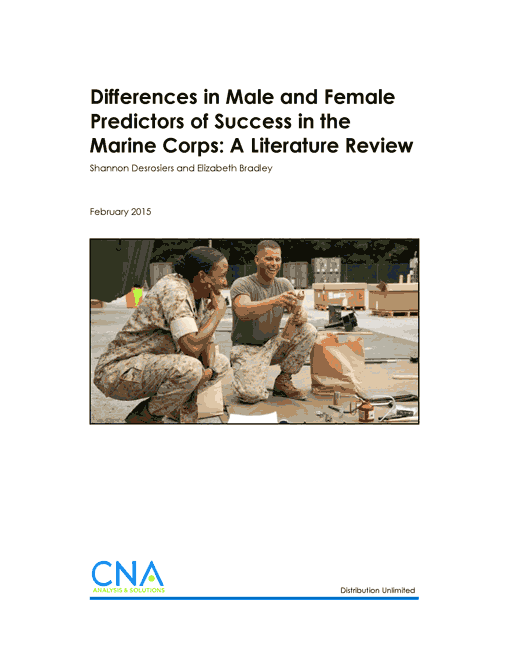Differences in Male and Female Predictors of Success in the Marine Corps
As part of the Marine Corps’ consideration of female integration into previously closed Military Occupational Specialties (MOSs) and units, the Marine Corps Force Innovation Office asked CNA to support the Marine Corps Recruiting Command’s (MCRC’s) research needs. CNA’s support to MCRC as part of the Marine Corps Force Integration Plan (MCFIP) includes a literature review on the predictors of male and female performance, direct support of MCRC in conducting trend analysis, and estimating the size of the qualified officer candidate population.
This research memorandum reviews the literature on predictors of Marine performance, separately for men and women. We reviewed the past 25 years of work on Marine performance for enlisted personnel and the officer corps, which will inform our work examining past gender integration as well as future trend analysis. Many studies of enlisted performance separately estimated effects by gender, but the officer studies did not.
Overall, we find that some factors are solid predictors of Marine Corps enlisted attrition and retention for both men and women. In general, spending more time in the Delayed Entry Program (DEP), having a higher Armed Services Qualification Test (AFQT) score, having a Tier 1 education credential, or being recruited as a high school senior were predictive of lower attrition (i.e., recruit-training and first-term attrition) and an increased likelihood of being recommended and eligible to reenlist for both male and female Marines. In terms of race and ethnicity, white non-Hispanic men and women have higher recruit-training and first-term attrition. Having no enlistment waivers was predictive of lower 24-month and first-term attrition for both men and women.
Other predictors of Marine Corps enlisted attrition, such as age, vary by gender. Being older was a predictor of higher attrition in the DEP, in recruit training, and at 24 months for men, but age was an insignificant predictor of female attrition.
In officer retention, promotion, and Fitness Report (FITREP) studies, researchers did not separately estimate equations by gender. Although we cannot glean anything about gender differences in performance predictors from these studies, we do observe that some factors—such as being married, having a higher ranking at The Basic School (TBS), being commissioned through the United States Naval Academy (USNA), or being a woman—were consistent predictors of higher officer retention, promotion, and FITREP scores at different paygrades and years of service.
Some factors were inconsistent predictors of officer retention, promotion, and FITREP scores at different paygrades, such as being prior enlisted, older, black, or holding an aviation MOS. Other factors were positive predictors of officer retention and promotion but insignificant predictors of officer FITREP scores, such as having a graduate degree or combat experience.
We also look at consistent predictors of enlisted promotion and good conduct. Poor conduct includes such factors as non-judicial punishments (NJPs) and desertions. Many factors that predicted high rates of enlisted retention also predicted high rates of enlisted promotion and good conduct. These factors included more time in DEP, a Tier 1 education credential, and higher AFQT scores. Among enlistment waiver types, some were consistent predictors of poor conduct, such as “positive drug and alcohol test,” “serious misdemeanor,” and “adult felony” waivers. Other factors, such as ethnicity and marital status, were less consistent predictors of enlisted promotion and good conduct.
There are several similarities between the predictors of enlisted and officer attrition, including such demographic characteristics as age, marital status, and gender. Some predictors, however, are not applicable to both groups. For example, time in DEP and the trimester in which a recruit ships to recruit training will not apply to the officer population. Instead, the officer retention studies investigate how commissioning source and TBS performance help to predict officer retention. Certain factors similarly predict enlisted and officer promotion, such as marital status and race, while other factors uniquely predict officer promotion—again, such as commissioning source and TBS ranking.
By understanding the strong predictors of past performance, we can better estimate the future performance of Marines. The information contained in this literature review will inform CNA’s other MCFIP work in support of MCRC’s research needs. In particular, we can use the identified predictors of Marine performance in (1) regression modeling of above- or below-average performance, as well as the ability or propensity to serve in combat arms MOSs, (2) trend analysis identifying the characteristics of female versus male Marine markets, and (3) analysis of whether the demographics and quality of female enlistees will change over time with the lifting of the combat exclusion policy.
Download reportCleared for Public Release; Distribution Unlimited. Specific authority: N00014-11-D-0323.
Details
- Pages: 60
- Document Number: DRM-2014-U-009327-FINAL
- Publication Date: 2/15/2015
